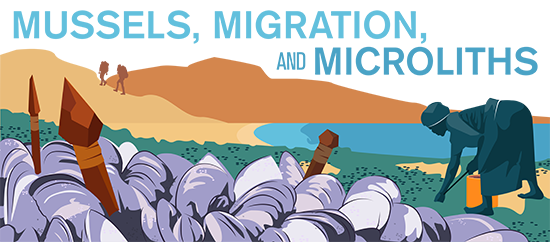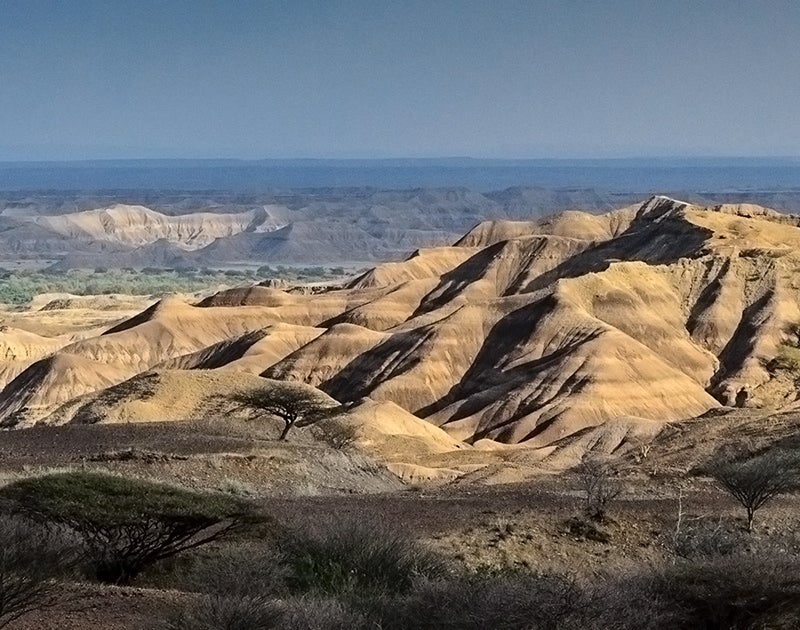
Mussels, Migration, and Microliths
 When did our human ancestors start thinking and acting like us? Where did “modern” humans originate and when did they spread out to cover the globe? These are some of the big questions paleoanthropologists—scientists who study of the origins of the human species—hope to answer. To do so, they have to look deep into the past. They use fossils and geology to understand ancient animals, climates, and human behavior.
When did our human ancestors start thinking and acting like us? Where did “modern” humans originate and when did they spread out to cover the globe? These are some of the big questions paleoanthropologists—scientists who study of the origins of the human species—hope to answer. To do so, they have to look deep into the past. They use fossils and geology to understand ancient animals, climates, and human behavior.
Some researchers are working at the southern coast of South Africa. They are studying where early humans were living in and around caves from around 200,000 years ago to the present.
Coastal living

ASU researcher Curtis Marean has spent over 20 years excavating caves in South Africa. He wanted to learn about the relationship between climate and environmental change and human evolution. All creatures are directly influenced by their environment. So, understanding what the climate was like in the past can tell us about the conditions in which species arose, went extinct, or changed form.
In 2000, Marean began work at one of the world’s most important archaelogolical sites. This is at a cave-filled promontory (a section of land that sticks out into water) at the tip of South Africa called Pinnacle Point near Mossel Bay.
 Marean’s excavations at Pinnacle Point have unearthed large amounts of shells from mussels, sea snails, and limpets. These artifacts tell us that the people living there were eating shellfish as early as 160,000 years ago. This is the earliest evidence we have for people feasting from the sea. This is important for a few reasons. A seafood diet provides essential nutrients—omega-3 fatty acids—that our bodies need, but we can’t make them ourselves. These acids are important for healthy brain function. Our ancestors probably would not have gotten them from a land-based diet alone.
Marean’s excavations at Pinnacle Point have unearthed large amounts of shells from mussels, sea snails, and limpets. These artifacts tell us that the people living there were eating shellfish as early as 160,000 years ago. This is the earliest evidence we have for people feasting from the sea. This is important for a few reasons. A seafood diet provides essential nutrients—omega-3 fatty acids—that our bodies need, but we can’t make them ourselves. These acids are important for healthy brain function. Our ancestors probably would not have gotten them from a land-based diet alone.
We also know that collecting shellfish is no easy task. These early people were keeping track of the moon cycles and ocean tides so that they could collect shellfish at the safest times. Eating shellfish also gave these early humans food security, because at those times seafood was plentiful. They had enough food so they could settle into one area. However, there can be a downside to productive and stable resources. They are attractive to potential competitors, need to be defended, and can lead to conflict.
Microlithic technology
Early modern humans also cooperated to create new technologies to hunt and to defend their homes. One of these new technologies appeared about 71,000 years ago: “microlithic” technology. Microliths are small stone tools created from a complex production process. Marean’s research at Pinnacle Point has revealed that 70,000 years ago, people were collecting a specific kind of rock. It is called silcrete and is still as plentiful around Pinnacle Point today as it was in the past.

These early people figured out how to build a pit fire to “heat treat” or bake the silcrete. This is so the rocks would be hard enough to flake off into small blades, which is called “knapping.” If the rock was baked too hard, it would shatter. If the rock was too soft, it would not break off into sharp, smooth pieces. They shaped the blades into very small, very sharp microliths and then mounted them on to wood or bone spears.
A complicated process like this requires a large, more developed brain to think through the entire process. This tells us that the folks living at Pinnacle Point were able to break down complex tasks into steps and execute them well. In short, they could think like us! These people attached microliths to spears, which they threw using tools like atlatls. They were able to hunt more safely and more efficiently than ever. They had made the most powerful weapons that had yet existed.
We're going places
Marean’s research suggests that these humans, working together with new weapons in hand, became a formidable force. They were the most dangerous predator in the world. When the climate changed from a warm interglacial to a colder glacial phase around 74,000 years ago, they were ready to leave Africa. By 65,000 years ago, modern humans had reached southeastern Asia. By 45,000 years ago, they were in western Europe. They had spread into the Arctic by 35,000 years ago, and by at least 13,500 years ago, they had moved all the way through the Americas. Wherever they went, extinctions followed. Extinctions include large mammals like mammoths or other hominins like our close relatives, the Neanderthals.
Thanks to Curtis Marean’s research, we are much closer to answering big evolutionary questions. Where did modern humans originate? When did they spread out to cover the globe?
About 195,000 years ago, a severe ice age began, and resources were limited. The number of people on the planet by around 150,000 years ago was likely very small. Perhaps they numbered as few as as 3,000 individuals! Marean thinks that those people were concentrated in South Africa, at sites like Pinnacle Point. They were surviving by using coastal resources like shellfish. The omega-3 fatty acids from these ocean foods helped them develop better brains. These people were able to cooperate with each other and develop more sophisticated tools than ever before.
These combined human developments—coastal occupation, cooperation, and microlithic technology—enabled humans to leave Africa and spread across the face of the earth in just 50,000 years. In evolutionary history, this is just a blink of an eye!
Curtis Marean earned his PhD from the University of California at Berkeley in 1990 for research on climate change and human and ecosystem responses in ancient East Africa. He is the Associate Director of the Institute of Human Origins and a Foundation Professor in the School of Human Evolution and Social Change at Arizona State University.
Bibliographic Details
- Article: Mussels, Migration, and Microliths
- Author(s): Amy Peterson, Alexandra Norwood
- Publisher: Arizona State University Institute of Human Origins Ask An Anthropologist
- Site name: ASU - Ask An Anthropologist
- Date published:
- Date modified:
- Date accessed: July 18, 2025
- Link: https://ask-an-anthropologist.net/profiles/mussels-migration-and-microliths
APA Style
Amy Peterson, Alexandra Norwood. (). Mussels, Migration, and Microliths. Retrieved 2025, Jul 18, from {{ view_node }}
American Psychological Association, 6th ed., 2nd printing, 2009.
For more info, see the
APA citation guide.
Chicago Manual of Style
Amy Peterson, Alexandra Norwood. "Mussels, Migration, and Microliths." ASU - Ask An Anthropologist. Published . Last modified . https://ask-an-anthropologist.net/profiles/mussels-migration-and-microliths.
Chicago Manual of Style, 17th ed., 2017.
For more info, see the
Chicago Manual citation guide.
MLA Style
Amy Peterson, Alexandra Norwood. Mussels, Migration, and Microliths. ASU - Ask An Anthropologist. , {{ view_node }}. Accessed July 18, 2025.
Modern Language Association, 8th ed., 2016.
For more info, see the
MLA citation guide.
Be Part of
Ask An Anthropologist
By volunteering, or simply sending us feedback on the site. Scientists, teachers, writers, illustrators, and translators are all important to the program. If you are interested in helping with the website we have a volunteers page to get the process started.

